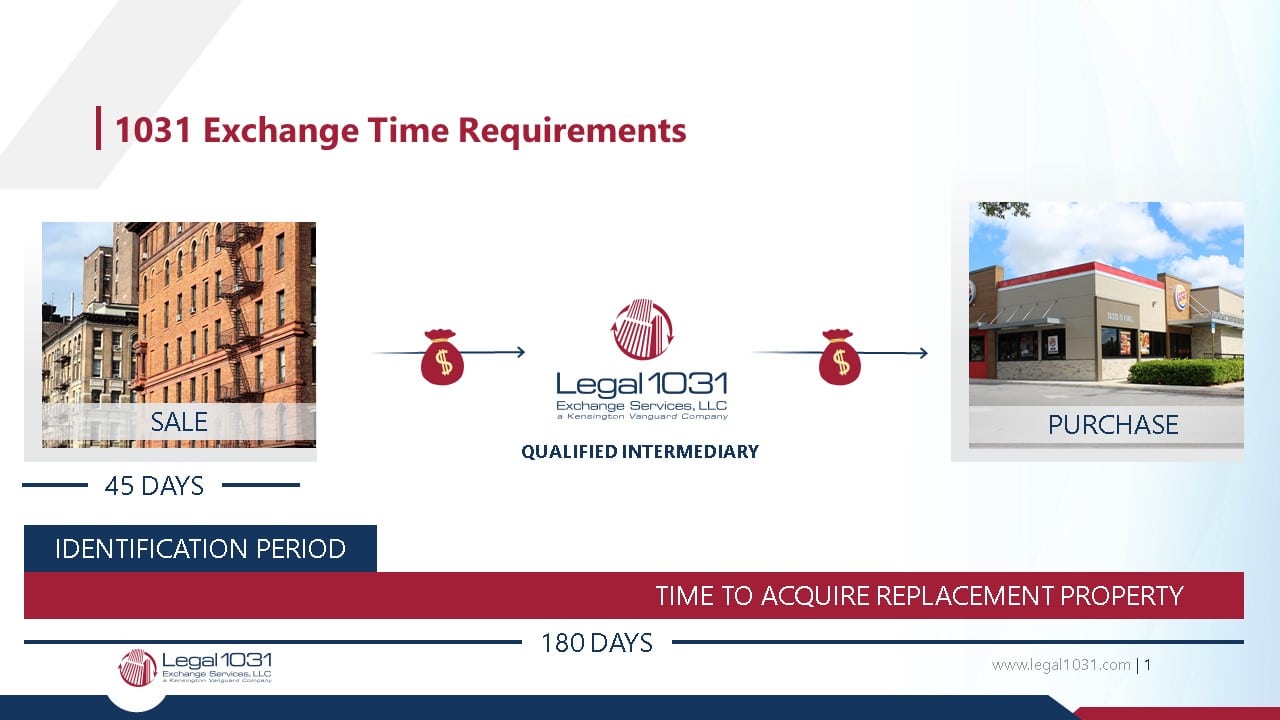Identification Rules and Identification Period
The Exchanger has 45-days from the date of the sale of the relinquished property to identify the potential replacement properties. The identification is a written (signed and dated by the taxpayer), unambiguous description of the property, and does not require that such properties be under contract or in escrow to qualify. Exchangers acquiring an undivided percentage interest (“fractional interest”) in a property should identify the specific percentage that will be acquired.
The Exchanger may change the properties identified as often as they want during the 45-day identification period by revoking the previously written identification and then identifying new potential replacement properties. It is essential that the identification is delivered by midnight of the 45th day, or postmarked by the 45th day, to the Exchanger’s Qualified Intermediary or to a party related to the exchange who is not a disqualified person. Typically, delivering the identification to the Qualified Intermediary is the safest course of action to prevent disqualification of the transaction for an invalid and/or untimely identification. If the Exchanger fails to deliver the identification on a timely basis or does not comply with one of the three identification options, the exchange will be disallowed.
To qualify for a 1031 exchange, the exchanger must choose and comply with one of the following identification options:
The Three Property Rule:
The “three property” identification rule allows an Exchanger to identify up to three replacement properties. There is no value limitation placed upon the prospective replacement properties and the exchanger can acquire one or more of the three properties as part of the exchange transaction. The “three property” rule is the most used identification option, allowing an exchanger to identify fall back properties in the event their preferred replacement property cannot be acquired.
The 200% Rule:
The Exchanger can identify an unlimited number of properties, provided that the total value of the properties identified does not exceed 200% of the value of all relinquished properties. There is no limitation on the total number of potential replacement properties identified under this rule, only a limitation on the total fair market value of the identified properties.
For example, if an Exchanger sold relinquished property for $1,000,000 under the 200% rule, the Exchanger would be able to identify as many replacement properties as desired, provided the aggregate fair market value of all of the identified properties does not exceed $2,000,000 (200% of the $1,000,000 sales price of the relinquished property).
The 95% Rule/Exception:
The Exchanger may identify an unlimited number of replacement properties exceeding the 200% of fair market value rule, however the Exchanger must acquire at least 95% of the fair market value of the properties identified. This rule is utilized in limited circumstances as there is a much higher risk of the transaction failing.
For example, assume an Exchanger identifies ten properties of equal value. To satisfy the rule, the Exchanger would be required to acquire all ten identified properties within the exchange period to complete a successful exchange. If the purchase of one of the properties fell through, the entire 1031 exchange will be disqualified because the exchanger did not acquire 95% of the fair market value identified (9/10 =90%). Of course, the result could be different in scenarios where some of the properties are more valuable than the others. This rule should only be utilized in situations where there is a high level of certainty pertaining to the acquisition of the identified properties and the other two rules do not meet the Exchanger’s objectives.
Legal 1031 Exchange Services, LLC does not provide tax or legal advice, nor can we make any representations or warranties regarding the tax consequences of any transaction. Taxpayers must consult their tax and/or legal advisors for this information. Unless otherwise expressly indicated, any perceived federal tax advice contained in this article/communication, including attachments and enclosures, is not intended or written to be used, and may not be used, for the purpose of (i) avoiding tax-related penalties under the Internal Revenue Code or (ii) promoting, marketing or recommending to another party any tax-related matters addressed herein.
Copyright © 2021 Legal1031 Exchange Services, LLC. All rights reserved. No rights claimed with respect to public domain and fair use materials contained or linked in this article.
Disclaimer: This article may be considered Attorney Advertising, per Rule 7.1(f) of the New York State Rules of Professional Conduct.
Michael L. Landsman, Esq., Partner at Falcon Rappaport & Berkman, and Todd R. Pajonas, Esq., President of Legal 1031 Exchange Services, LLC, discuss the 1031 Identification of Replacement Property Rules.
*Video to come…stay tuned.

